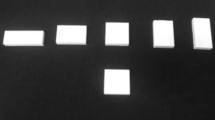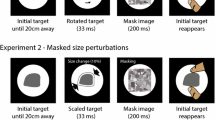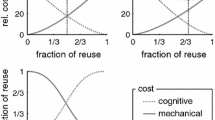Abstract
The motor control of a sequence of two motor acts forming an action was studied in the present experiment. The two analysed motor acts were reaching-grasping an object (first target) and placing it on a second target of the same shape and size (experiment 1). The aim was to determine whether extrinsic properties of the second target (i.e. target distance) could selectively influence the kinematics of reaching and grasping. Distance, position and size of both targets were randomly varied across the experimental session. The kinematics of the initial phase of the first motor act, that is, velocity of reaching and hand shaping of grasping, were influenced by distance of the second target. No kinematic difference was found between movements executed with and without visual control of both hand and targets. These results could be due to computation of the general program of an action that takes into account extrinsic properties of the final target. Conversely, they could depend on a visual interference effect produced by the near second target on the control of the first motor act. In order to dissociate the effects due to second target distance from those due to visual interference, two control experiments were carried out. In the first control experiment (experiment 2) subjects executed movements directed towards spatial locations at different distances from the first target, as in experiment 1. However, the near second target was not presented and subjects were required to place the object on an arbitrary near position. Distance of the second (either real or arbitrary) target affected the reaching component of the first motor act, as in experiment 1, but not the grasp component. In the second control experiment (experiment 3), the pure visual interference effect was tested. Subjects were required to reach and grasp the object and to lift it in either presence or absence of a second near stimulus. No effect on the initial phase of the first motor act was observed. The results of the this study suggest a dissociation in the control of reaching and grasping, concerning not only visual analysis of extrinsic properties of the immediate target but also visual analysis of the final target of the action. In other words, the notion of modularity for the motor control can be extended to the construction of an entire action.
Similar content being viewed by others
Author information
Authors and Affiliations
Additional information
Received: 26 July 1996 / Accepted: 19 December 1996
Rights and permissions
About this article
Cite this article
Gentilucci, M., Negrotti, A. & Gangitano, M. Planning an action. Exp Brain Res 115, 116–128 (1997). https://doi.org/10.1007/PL00005671
Issue Date:
DOI: https://doi.org/10.1007/PL00005671




